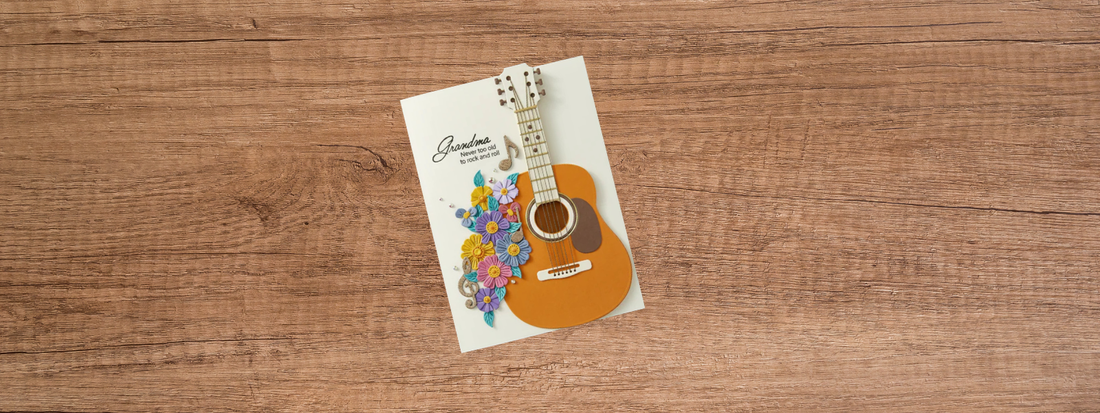
What Are Cutting Dies?
Share
If you've ever admired perfectly shaped paper cut-outs, intricate card designs, or identical fabric pieces in crafting projects, the secret ingredient behind them is likely a cutting die.
A cutting die is a metal template used with a die-cutting machine to precisely cut shapes out of materials like cardstock, fabric, felt, foam, and even thin metals. Think of it as a super-sharp cookie cutter for paper crafts, it guarantees clean edges and perfect consistency every single time.
This guide will walk you through what cutting dies are, how they work, the different types available, and how you can use them to elevate your crafting.
How Do Cutting Dies Work with a Die-Cutting Machine?

The process of using a cutting die is often referred to as die-cutting. It’s essentially a specialised form of pressing or stamping.
- The Sandwich: You create a "sandwich" consisting of the cutting plate, the cutting die (with the blade facing up), and the material you want to cut (like cardstock).
- The Press: This sandwich is placed onto the platform of a die-cutting machine.
- The Roll: The machine uses a crank (manual) or an electronic motor (automatic) to roll the sandwich through a set of powerful rollers.
- The Result: The immense pressure forces the material against the sharp edge of the cutting die, slicing through it to leave a perfectly cut shape. The remaining material (the waste) is removed, and the cut shape is referred to as the "die-cut."
This high-pressure method is why cutting dies can handle materials that standard craft punches or scissors couldn't cut cleanly or accurately.
Understanding the Two Main Types of Cutting Dies
Not all cutting dies are the same! They are generally categorised based on their construction and the type of materials they can cut.
Thin Metal Dies (Wafer Dies)
These are the most common cutting dies used by cardmakers and scrapbooking enthusiasts.
| Feature | Description |
|---|---|
| Material | Made from a thin sheet of etched or chemically milled steel. |
| Size | Very thin and compact; easy to store. |
| Usage | Best for thin materials like paper, cardstock, vellum, glitter paper, and thin foam. |
| Detail | Can achieve extremely intricate, delicate, and detailed designs, such as lace patterns or small lettering. |
Steel-Rule Dies (Thick Dies)
These are heavy-duty cutting dies designed for more robust projects.
| Feature | Description |
|---|---|
| Material | Sharp steel blades bent into shape and firmly embedded into a durable wooden base or hard foam block. |
| Size | Thick or dense materials like chipboard, magnet sheets, leather, denim, felt, and cutting multiple layers of fabric at once. |
| Usage | These are often used for larger, simpler shapes like letters, bags, boxes, and quilting shapes, where cutting strength is more important than intricate detail. |
| Detail | Unmatched cutting power for thick materials, making them essential for appliqué, sewing projects, and creating sturdy dimensional items. |
Why Use Cutting Dies? The Benefits for Crafters
Consistency and Precision
The single biggest benefit is getting perfectly identical shapes every time. If you need 50 perfectly shaped stars for a party banner or matching lace edges for an album, a cutting die ensures that the first cut is identical to the fiftieth.
Speed and Efficiency
Once you have the die and the machine set up, generating dozens of complex cut-outs takes minutes, not hours. This makes die-cutting invaluable for making batches of invitations, holiday cards, or items for sale.
Intricate Detail
It's impossible to cut extremely fine details, like filigree or delicate script fonts, by hand. Cutting dies allow you to incorporate stunning complexity into your projects that you simply couldn't achieve otherwise.
Versatility
Because you can get cutting dies for almost any theme, from flowers and animals to tags and alphabet letters, they open up an endless world of creative possibilities across different mediums like paper crafting, sewing, and mixed media art.

Which Die-Cutting Machine is Right for Your Cutting Dies?
The type of machine you need depends entirely on the type of cutting dies you plan to use:
Manual Machines: These are the standard "turn the handle" machines. They work with both thin metal dies and some smaller steel-rule dies. They require no electricity and are durable and portable.
Electronic Machines: Machines like the Cricut or Silhouette don't typically use traditional metal cutting dies. Instead, they use a small blade that moves according to a digital file. While versatile, they are a different tool category than traditional die-cutters, which use the physical metal templates.
Industrial/Pro Machines: These powerful, wide-format machines are designed specifically to use the largest steel-rule dies to cut thick materials like carpets, signage, and very thick fabric in high volumes.
When buying a machine, always check the specifications to ensure it is compatible with the size and thickness of the cutting dies you want to use.
